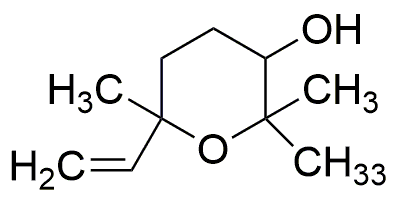2,2,6-Trimethyl-6-vinyltetrahydropyran-3-ol is widely utilized in research focused on:
- Flavor and Fragrance Industry: This compound is used as a flavoring agent in food products and as a fragrance component in cosmetics and perfumes, providing a pleasant scent and taste.
- Pharmaceutical Development: It serves as an intermediate in the synthesis of various pharmaceutical compounds, helping to create medications with specific therapeutic effects.
- Polymer Chemistry: The compound is employed in the production of specialty polymers, enhancing properties like flexibility and durability, which are crucial for applications in coatings and adhesives.
- Aromatherapy Products: It is incorporated into essential oil blends for aromatherapy, promoting relaxation and well-being through its aromatic properties.
- Research in Organic Chemistry: This chemical is a valuable reagent in organic synthesis, aiding researchers in developing new compounds and studying reaction mechanisms.
Informations générales
Propriétés
Sécurité et réglementation
Applications
2,2,6-Trimethyl-6-vinyltetrahydropyran-3-ol is widely utilized in research focused on:
- Flavor and Fragrance Industry: This compound is used as a flavoring agent in food products and as a fragrance component in cosmetics and perfumes, providing a pleasant scent and taste.
- Pharmaceutical Development: It serves as an intermediate in the synthesis of various pharmaceutical compounds, helping to create medications with specific therapeutic effects.
- Polymer Chemistry: The compound is employed in the production of specialty polymers, enhancing properties like flexibility and durability, which are crucial for applications in coatings and adhesives.
- Aromatherapy Products: It is incorporated into essential oil blends for aromatherapy, promoting relaxation and well-being through its aromatic properties.
- Research in Organic Chemistry: This chemical is a valuable reagent in organic synthesis, aiding researchers in developing new compounds and studying reaction mechanisms.
Documents
Fiches de données de sécurité (FDS)
La FDS fournit des informations de sécurité complètes sur la manipulation, le stockage et l’élimination du produit.
Spécifications du produit (PS)
Le PS fournit une description complète des propriétés du produit, notamment sa composition chimique, son état physique, sa pureté et les exigences de stockage. Il détaille également les plages de qualité acceptables et les applications prévues du produit.
Certificats d'analyse (COA)
Recherchez des certificats d'analyse (COA) en saisissant le numéro de lot du produit. Les numéros de lot et de lot se trouvent sur l'étiquette d'un produit, après les mots « Lot » ou « Lot de fabrication ».
Numéro de catalogue
Numéro de lot/série
Certificats d'origine (COO)
Ce certificat d'exploitation confirme le pays dans lequel le produit a été fabriqué, et détaille également les matériaux et composants utilisés et s'il est issu de sources naturelles, synthétiques ou autres sources spécifiques. Ce certificat peut être requis pour les douanes, le commerce et la conformité réglementaire.
Numéro de catalogue
Numéro de lot/série
Fiches de données de sécurité (FDS)
La FDS fournit des informations de sécurité complètes sur la manipulation, le stockage et l’élimination du produit.
DownloadSpécifications du produit (PS)
Le PS fournit une description complète des propriétés du produit, notamment sa composition chimique, son état physique, sa pureté et les exigences de stockage. Il détaille également les plages de qualité acceptables et les applications prévues du produit.
DownloadCertificats d'analyse (COA)
Recherchez des certificats d'analyse (COA) en saisissant le numéro de lot du produit. Les numéros de lot et de lot se trouvent sur l'étiquette d'un produit, après les mots « Lot » ou « Lot de fabrication ».
Numéro de catalogue
Numéro de lot/série
Certificats d'origine (COO)
Ce certificat d'exploitation confirme le pays dans lequel le produit a été fabriqué, et détaille également les matériaux et composants utilisés et s'il est issu de sources naturelles, synthétiques ou autres sources spécifiques. Ce certificat peut être requis pour les douanes, le commerce et la conformité réglementaire.


